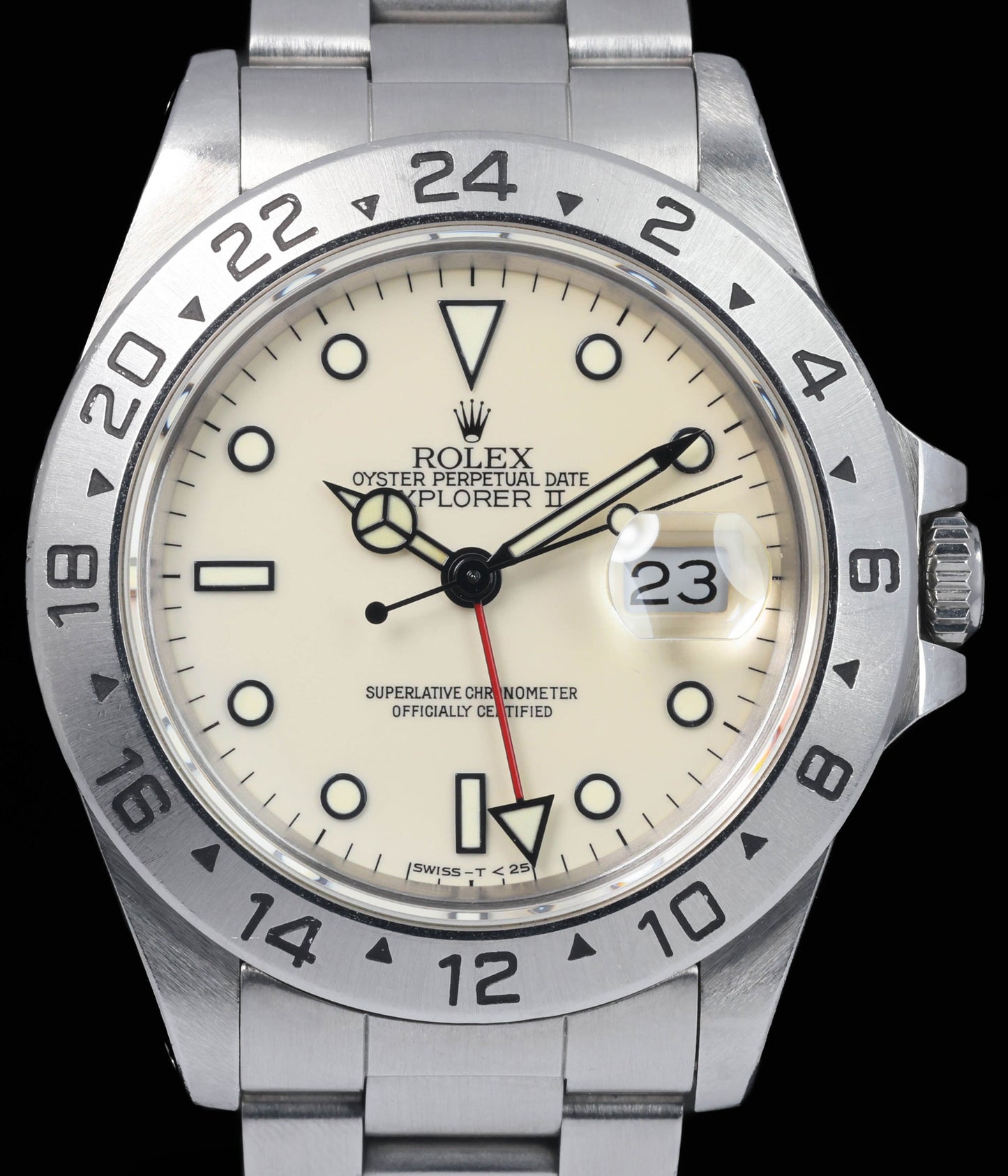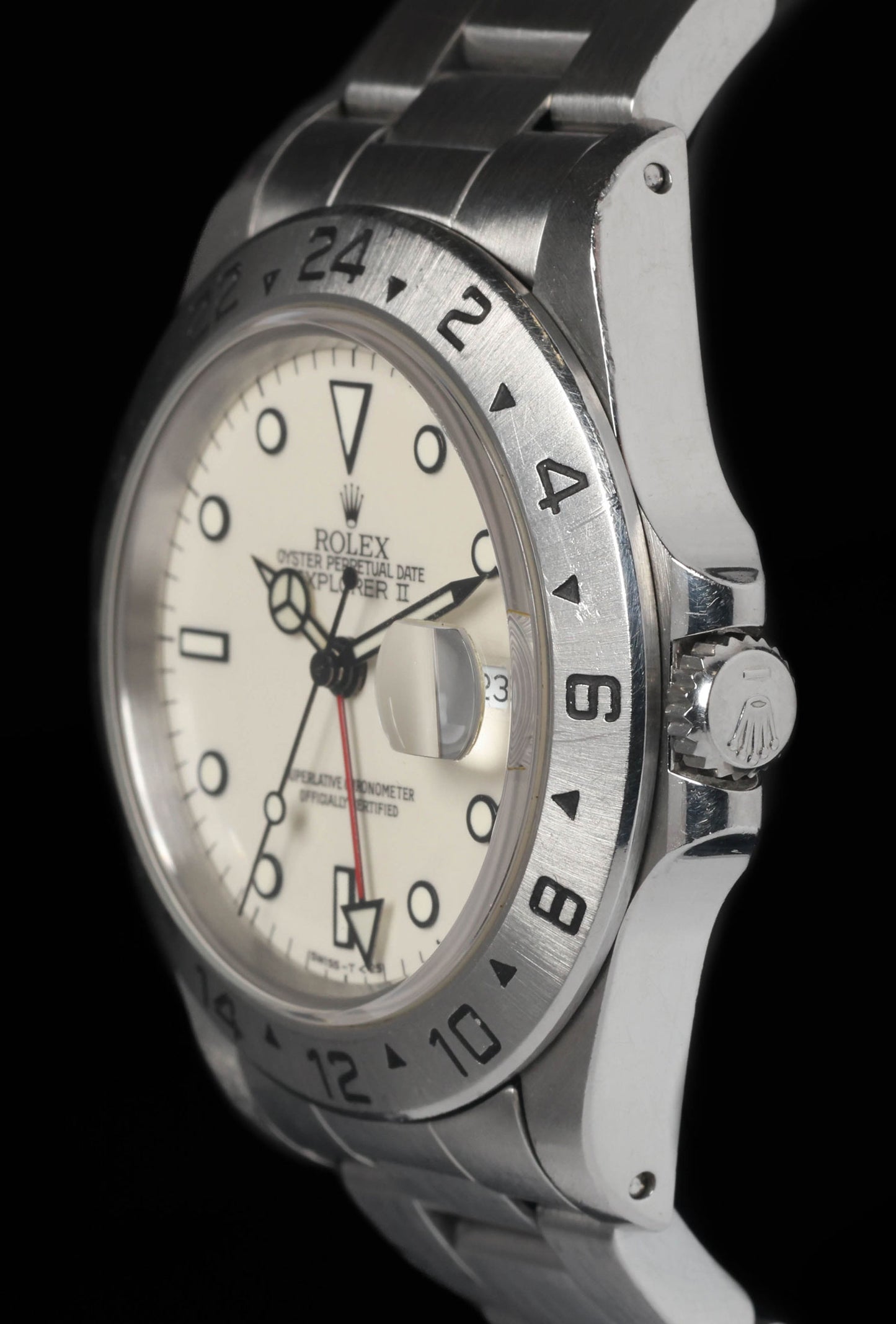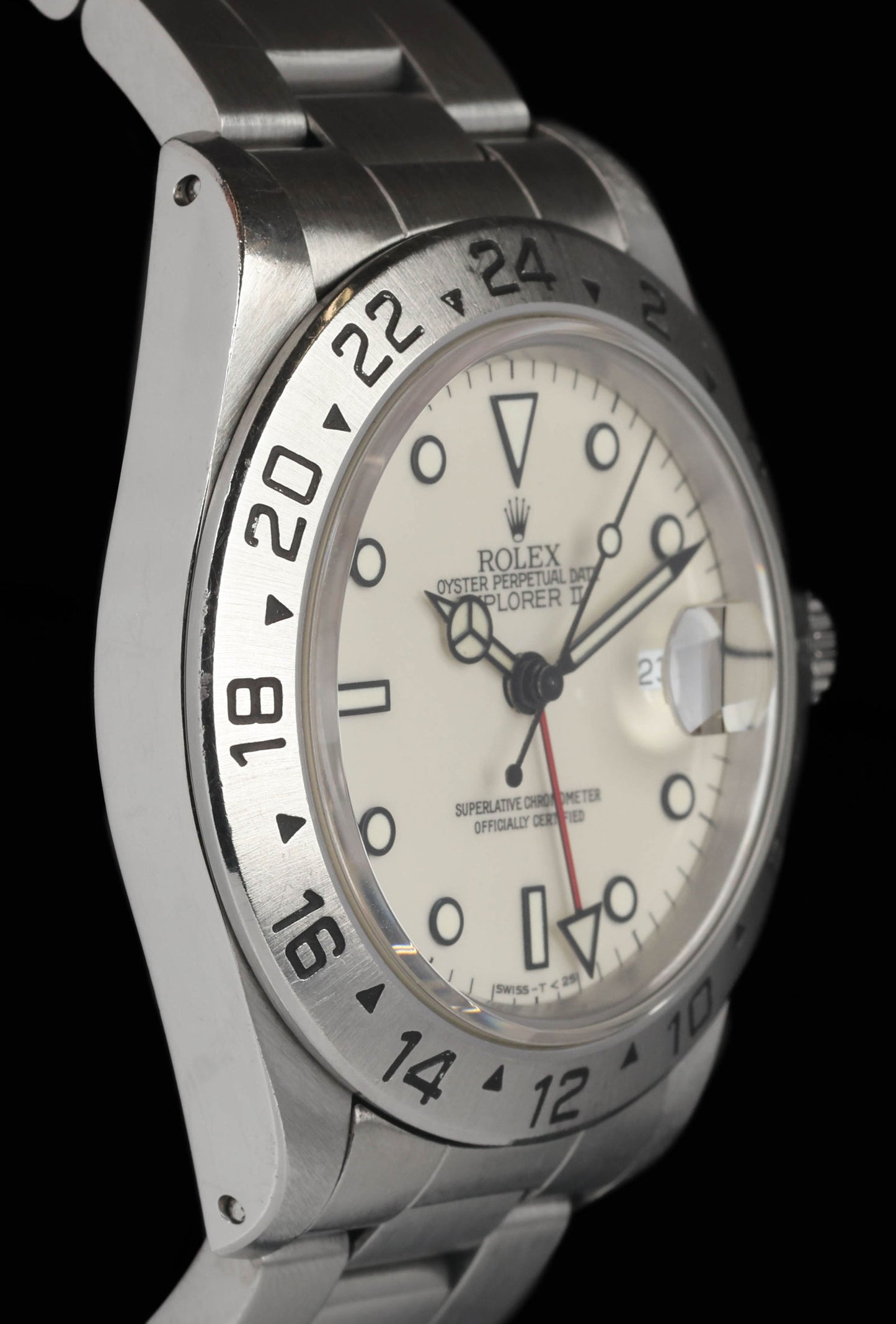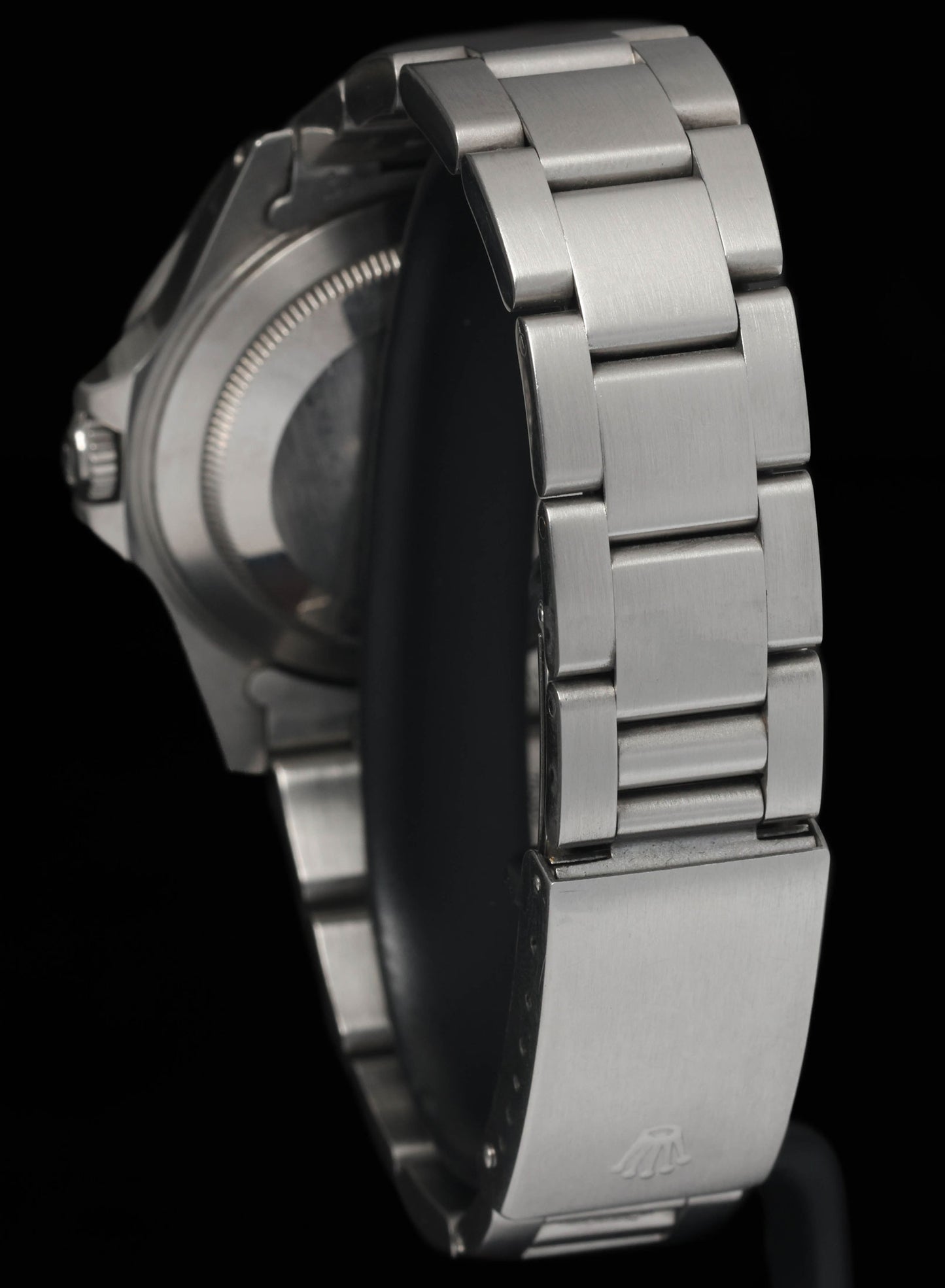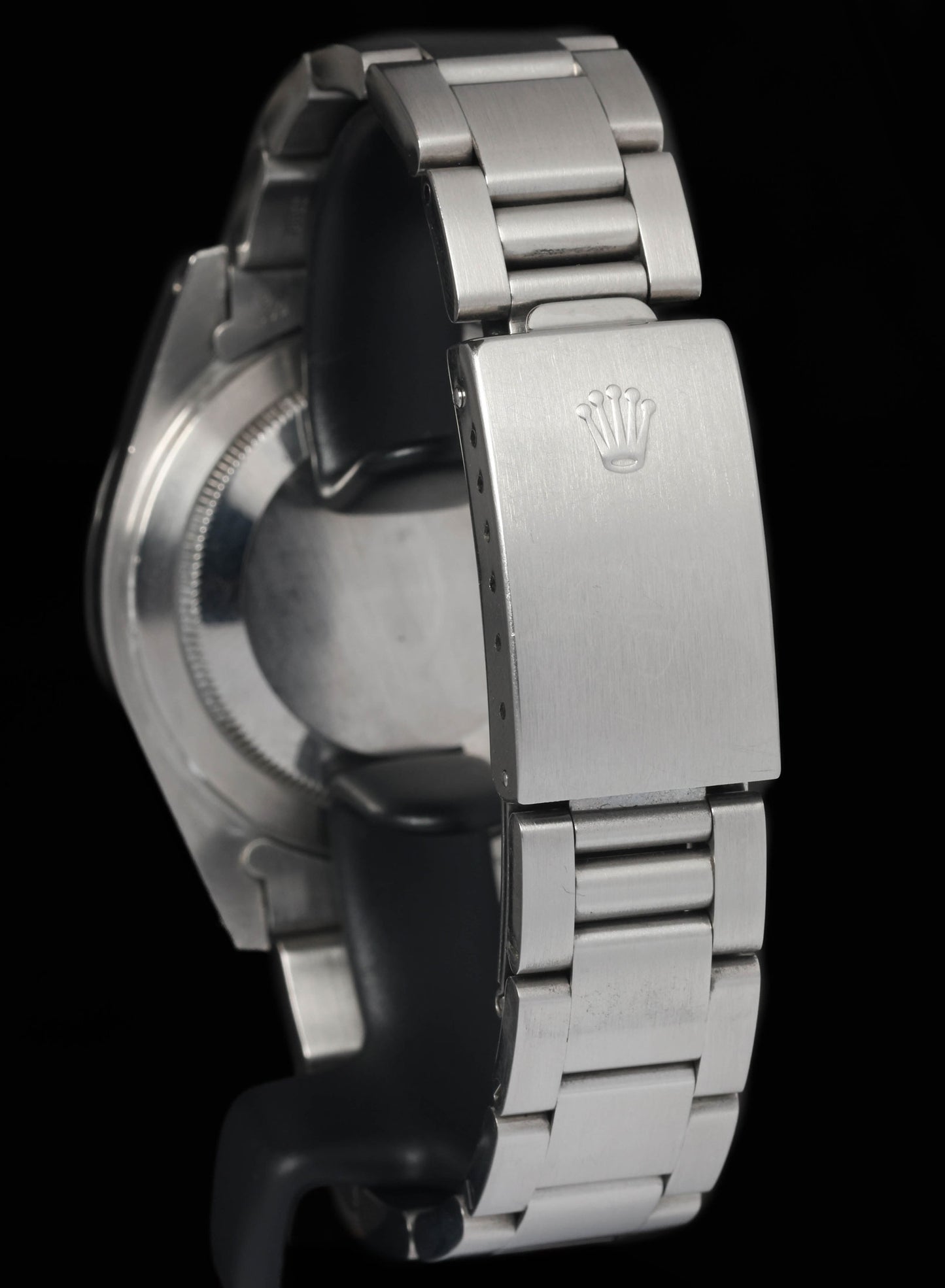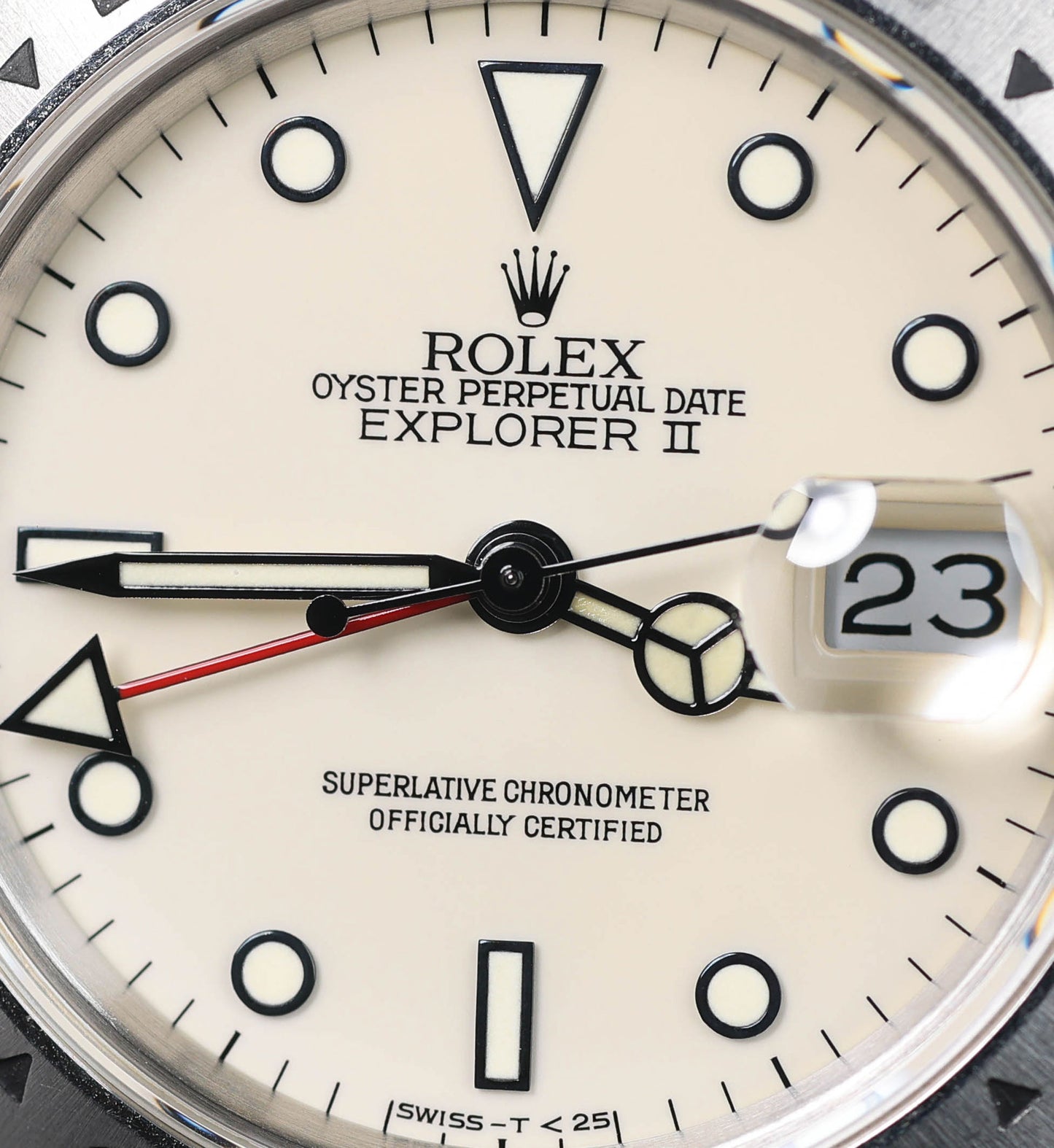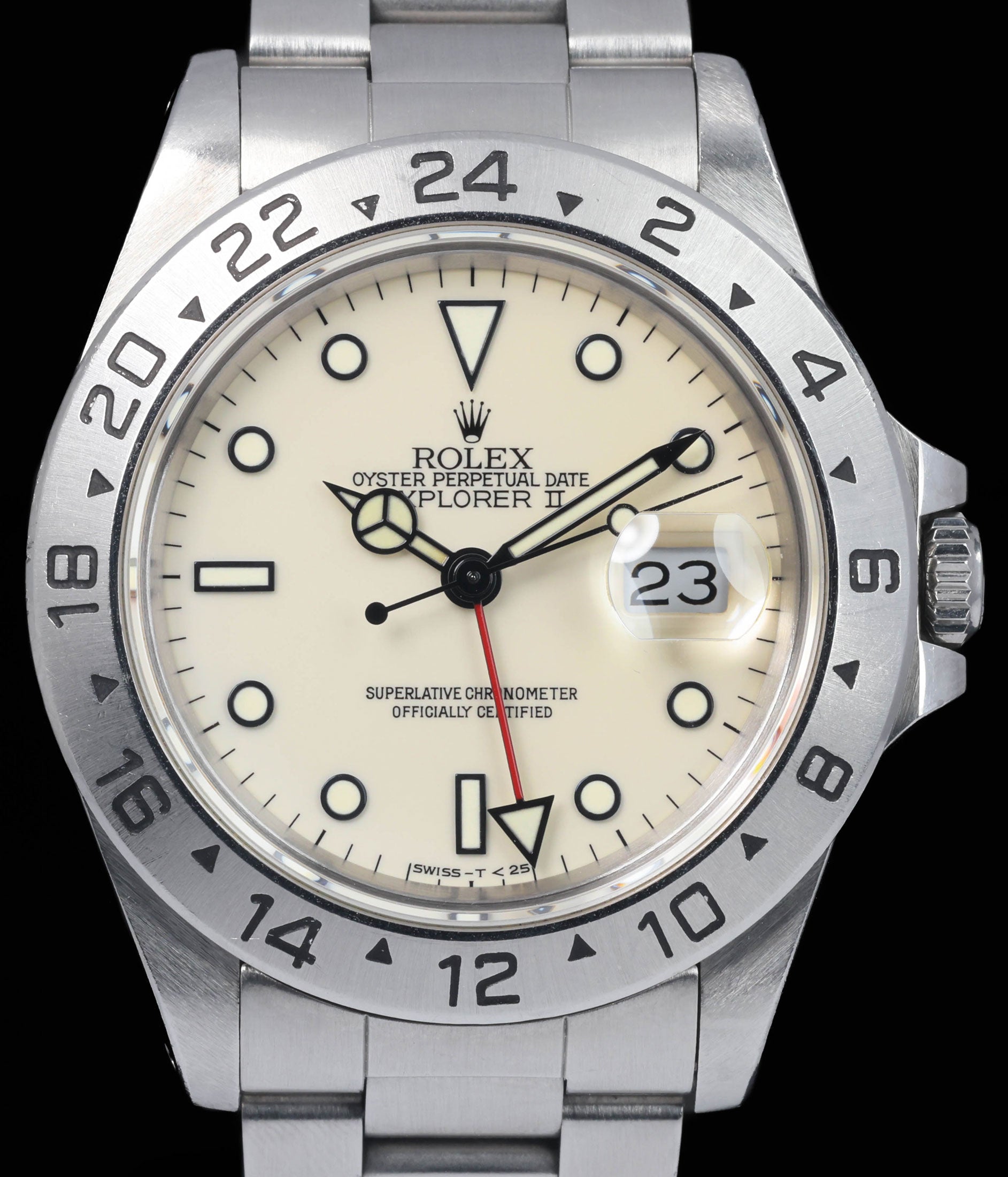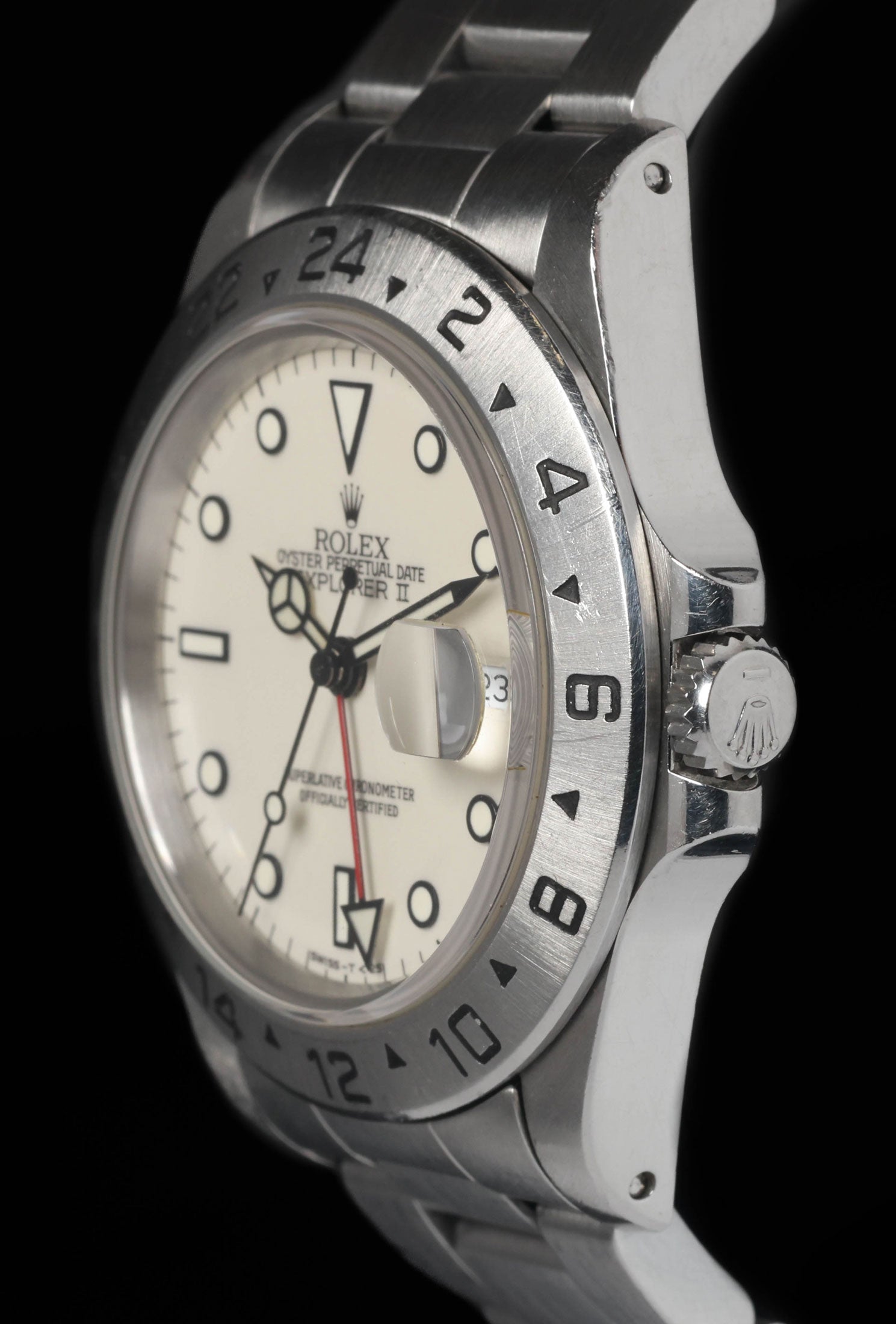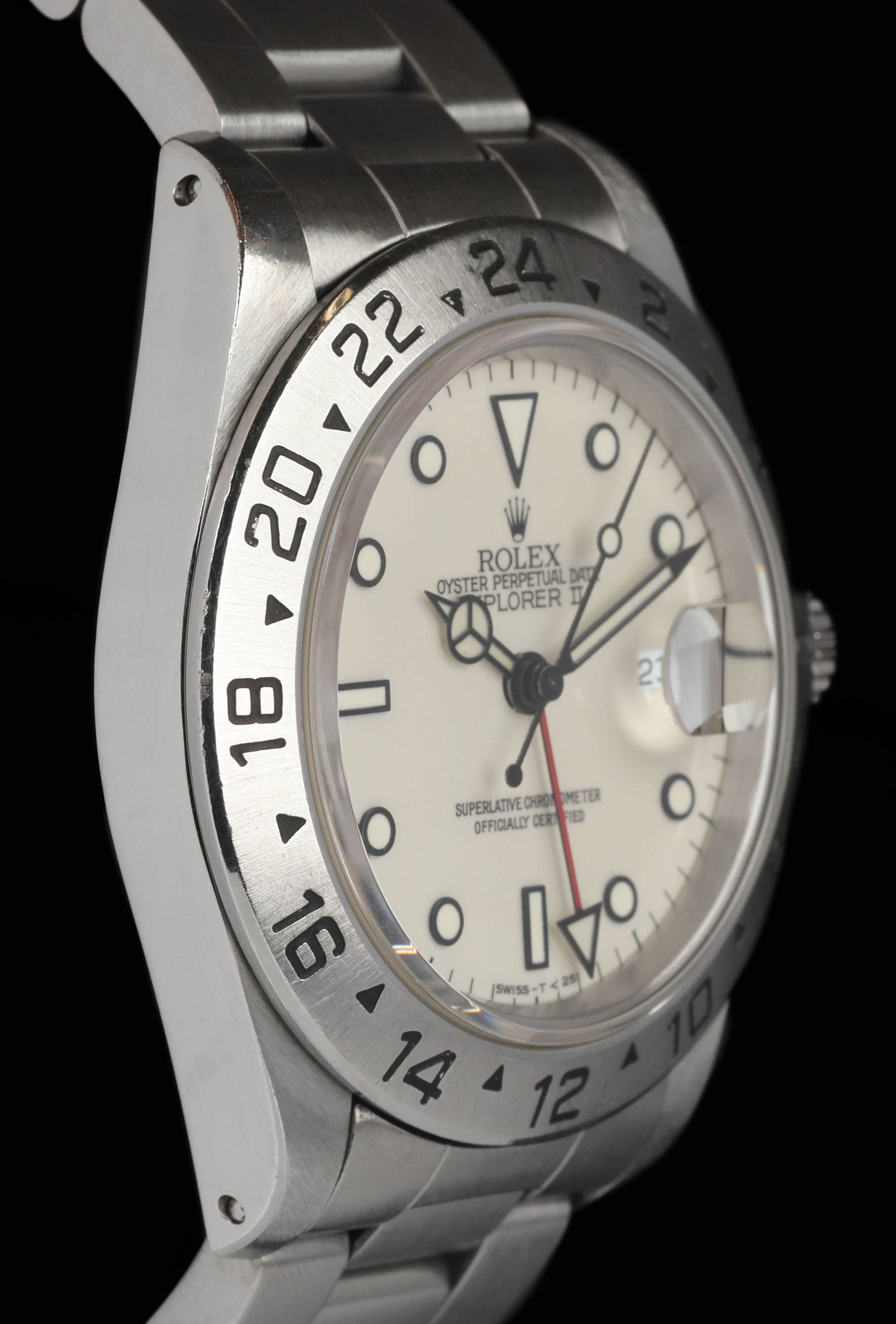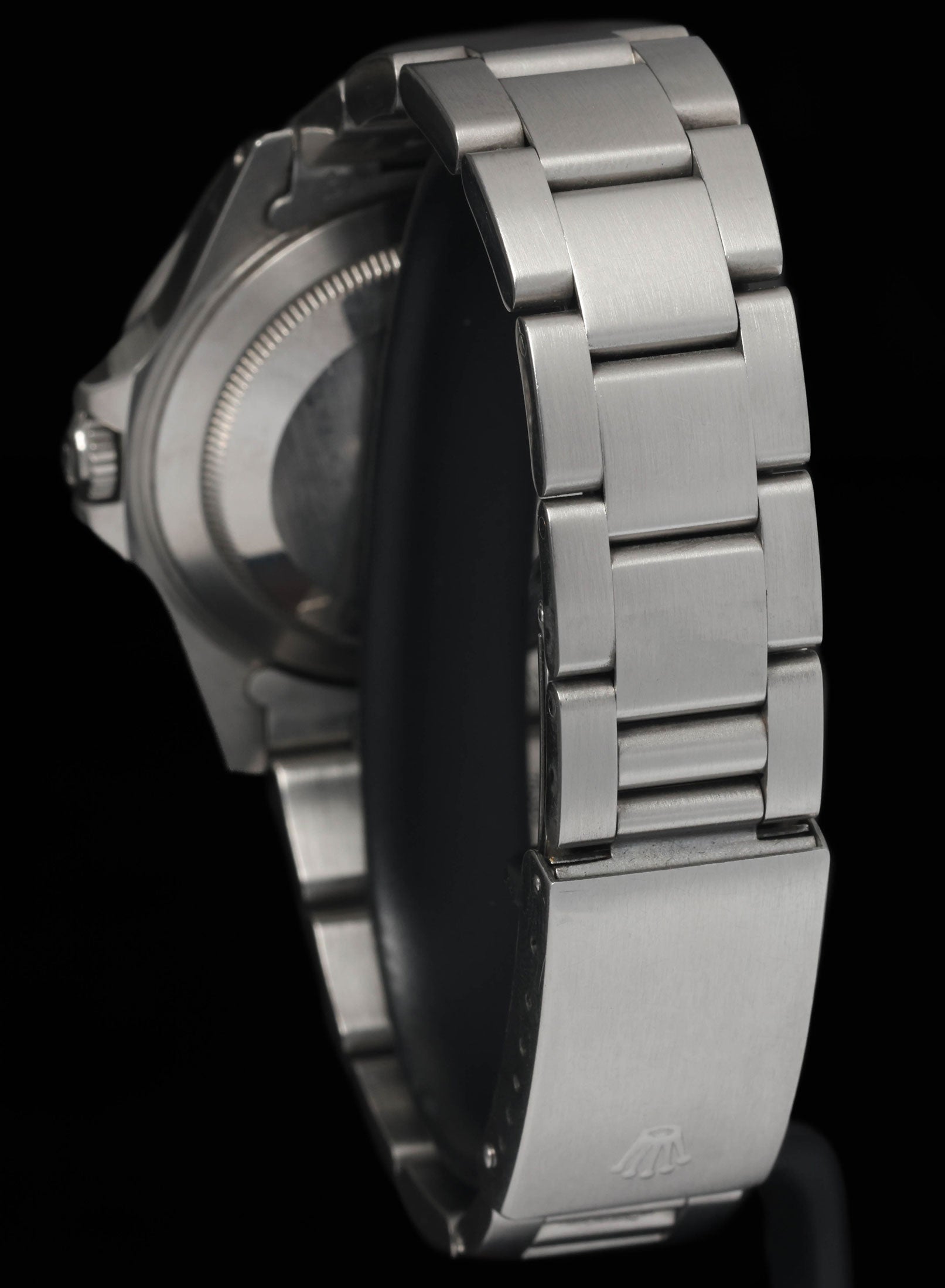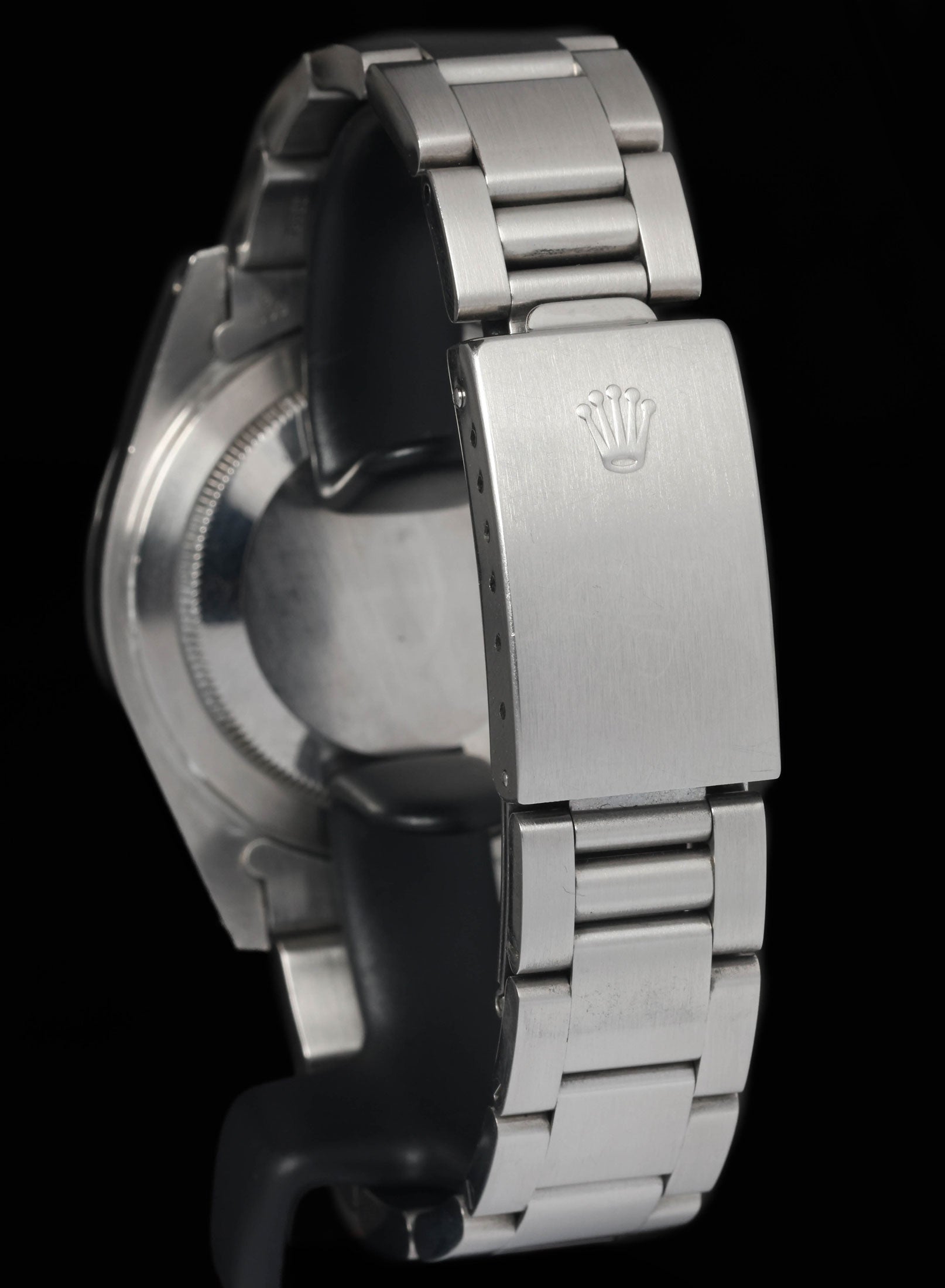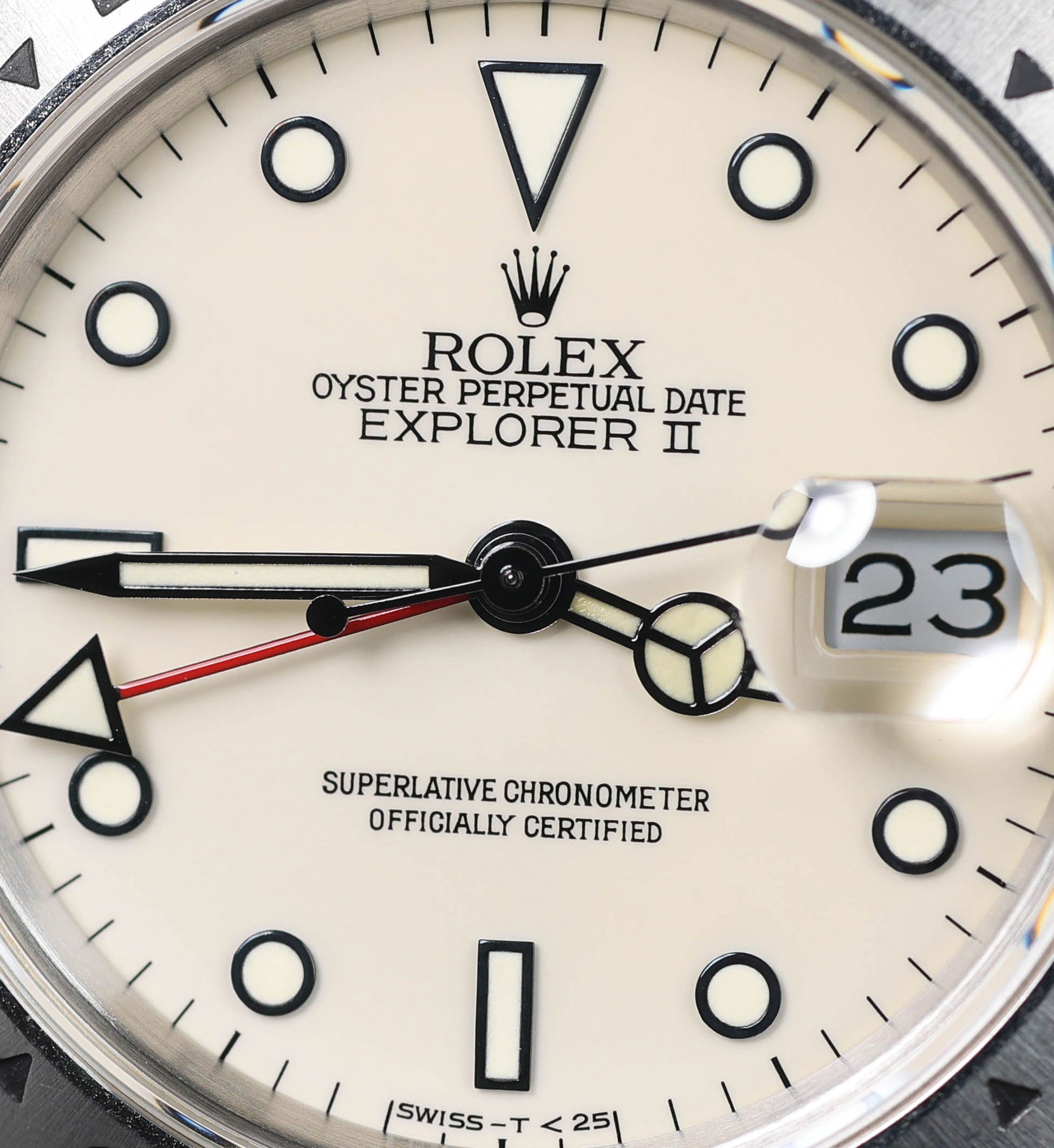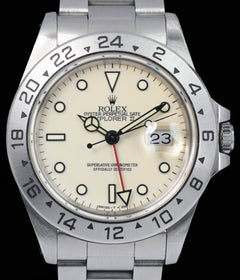Crown Vintage
Rolex Explorer II 16570 'Panna Dial' 40MM 1991
Rolex Explorer II 16570 'Panna Dial' 40MM 1991
Couldn't load pickup availability
Rolex Explorer II 16570 'Panna Dial' 40MM 1991
The stainless-steel case is in great vintage condition, with hairlines visible on both sides consistent with honest wear. A small pinhead chip is present on the crown-side lug but does not detract from the overall appearance. The case has been lightly polished in the past, though the lugs retain good proportions and the brushing across the upper surfaces remains clear. The fixed 24-hour bezel is well preserved, with deep, legible engraving and only light signs of age.
The Oyster bracelet remains in very good condition, showing light hairlines and modest stretch expected from use, with the clasp operating securely.
The dial is the true centrepiece of this watch. Originally produced in stark white, it has, over time, taken on a rare and beautiful creamy hue now referred to as “panna.” This change was never intentional. It is the result of how Rolex’s lacquer and pigment chemistry of the period interacted with light, temperature shifts, and decades of natural ageing. Unlike later, more stable dials, these early Polar examples carried within them the potential to transform. The result is not a flaw but a unique fingerprint of time. The patina is evenly spread, lending the dial a warm character that sits in striking contrast to the crisp black surrounds of the hour markers. The tritium lume plots and hands have aged consistently, now displaying a subtle warmth that harmonises perfectly with the panna tone.
The sapphire crystal is clean and scratch-free. Inside, the calibre 3185 automatic movement is running well, with all functions operating as intended, including the independently adjustable 12-hour hand and GMT complication.
Share
Why we love this watch
Why we love this watch
Rolex Explorer II 16570: A Classic Tool Watch with a Rare Panna Dial
Introduction
Introduced at the close of the 1980s and produced through the mid-2000s, it represents the second generation of the Explorer II line. With its fixed 24-hour bezel, GMT functionality, and rugged stainless-steel case, the 16570 was designed for the most demanding environments. While the Submariner and GMT-Master were the brand’s headline-grabbing sports watches, the Explorer II quietly cemented itself as the adventurer’s watch, favoured by those who needed a reliable tool rather than a status symbol.
This particular example from the early production years stands out for one rare detail: the panna dial. Originally manufactured in crisp white, the dial has developed a creamy tone over time. Known among vintage circles as “panna” for its resemblance to Italian cream, this dial variant is both visually striking and historically significant. It tells the story not only of Rolex’s design choices but also of how natural ageing processes can elevate a watch into the realm of the unique.
The Origins of the Explorer II
To understand the 16570, it is essential to look back at the roots of the Explorer II line. The first Explorer II, reference 1655, was launched in 1971. It was a watch designed with cave explorers and speleologists in mind. Its most distinctive feature was the 24-hour fixed bezel paired with a large orange GMT hand, allowing the wearer to distinguish day from night in environments where natural light was absent.
The 1655 was unlike any other Rolex sports watch. It did not rotate like the GMT-Master, and it lacked the glamour of the Submariner, but it was purposeful and unique. Nicknamed the “Freccione” for its bold orange arrow hand, the 1655 developed a cult following. After more than a decade in production, it was replaced by the 16550 in the mid-1980s. That watch introduced sapphire crystals, an upgraded case design, and the option of a white dial alongside black. However, the 16550 also revealed one of Rolex’s unexpected quirks: many of the white dials turned creamy over time, creating what became known as the cream or “panna” dial.
The Arrival of the 16570
By the late 1980s, Rolex refined the Explorer II further with the introduction of the reference 16570. This model carried forward the dual dial options, black and white, but introduced a number of technical and aesthetic improvements. It retained the fixed 24-hour bezel, now in stainless steel with engraved numerals, and measured 40mm across, a size that was substantial but wearable. The dial featured classic Mercedes-style hands, a red GMT hand for the second time zone, and luminous markers filled with tritium in the early production years.
The movement inside was the calibre 3185, an automatic GMT movement that allowed independent setting of the 12-hour hand, making it a true traveller’s watch. Later in production, the calibre 3186 was introduced with improved balance bridge construction, but the fundamentals remained the same. The Explorer II was not a flashy watch. It was built to be functional, robust, and legible in all conditions, true to the ethos of the Explorer line.
The White Dial and the Panna Phenomenon
The 16570 was offered with either a black or white dial, the latter often referred to as the “Polar.” The white dial was particularly striking, providing sharp contrast with the black hour markers and hands. However, certain early examples developed an unexpected patina over time. Instead of remaining crisp white, the lacquered surface aged to a creamy shade, giving rise to the “panna” designation.
This tonal shift is subtle yet transformative. The creamy dial softens the overall look of the watch, lending warmth to an otherwise stark design. It also underscores one of the most fascinating aspects of vintage Rolex: the unpredictability of materials. No two panna dials are identical. Some are evenly toned, while others display slight variations across the surface. This individuality elevates panna dial examples into a category of their own, making them highly distinctive within the Explorer II family.
Case and Bracelet Design
The stainless-steel Oyster case of the 16570 measured 40mm in diameter, aligning with other professional Rolex models of the era. Its brushed lugs and polished sides created a purposeful yet refined aesthetic. The fixed bezel, engraved with 24-hour numerals, distinguished the Explorer II from the GMT-Master line and reinforced its identity as a tool for explorers rather than jet-setters.
Fitted with an Oyster bracelet, the watch was practical and secure. Early examples used hollow end links, later transitioning to solid end links as Rolex continued to refine its bracelets. The flip-lock clasp added further security, ensuring the watch remained fastened in challenging conditions. On the wrist, the 16570 wears comfortably, neither oversized nor too compact, and has become something of a benchmark for sports watch proportions.
The Movement Within
Powering the early 16570 was the calibre 3185, a GMT movement based on Rolex’s 3135 architecture. It offered a quick-set date and an independently adjustable 12-hour hand, enabling easy tracking of a second time zone. This function distinguished the Explorer II from its predecessor, the 16550, which had introduced the white dial option but not yet fully refined the GMT functionality.
Its successor, the 3186, was introduced toward the end of the 16570’s production, adding a more stable balance bridge and minor refinements. Together, these movements ensured the Explorer II maintained its reputation as a practical travel and exploration companion.
Early 1990s Examples and the Panna Dial
The panna dial phenomenon is most commonly associated with examples produced during the early years of the 16570. While Rolex likely did not anticipate the ageing effect at the time, it has since become one of the most desirable quirks of the model. A panna dial transforms the appearance of the Explorer II, softening the high-contrast design into something more subtle and unique.
In the context of a 1991 example, this detail is especially significant. The watch represents both the early stages of the 16570’s production and the continuation of the cream dial legacy first seen on the 16550. For those interested in Rolex history, it is a watch that connects the brand’s transitional experimentation of the 1980s with the more refined stability of the 1990s.
The Explorer II in the 1990s Landscape
The 1990s were a transformative period for Rolex. The brand was modernising its sports watches, introducing solid end links, sapphire crystals, and improved movements. Yet the Explorer II remained true to its tool-watch ethos. While the Submariner and GMT-Master gained ceramic bezels and precious metal variants in later years, the 16570 stuck to its stainless-steel construction and fixed bezel, appealing to those who valued function over luxury.
In many ways, the Explorer II was the understated choice. It did not draw the same attention as the Daytona or Submariner, but it embodied the practical philosophy of Rolex at its core. The panna dial examples from this period highlight the balance between durability and individuality. They remind us that even within Rolex’s famously consistent production, unexpected variations can occur, creating watches with distinct character.
The Explorer II Legacy
The Explorer II line has always been slightly apart from Rolex’s mainstream. It is not a dive watch, nor is it a pilot’s watch in the conventional sense. It was conceived for a niche purpose—spelunking and polar exploration—but it has found a broader audience among those who appreciate its restrained design and specialised functionality.
The 16570 carried this legacy into the modern era, bridging the gap between the vintage charm of the 1655 and 16550 and the contemporary scale of the current 42mm 216570 and its successor, the 226570. It represents a sweet spot in size, design, and functionality. Its panna dial examples, in particular, offer a rare glimpse into how Rolex’s materials and finishing techniques of the time could create unexpected outcomes.
Final Thoughts
The Rolex Explorer II 16570 is a watch that deserves greater recognition. While it may have lived in the shadows of Rolex’s more famous sports models, it has quietly built a legacy of reliability, purpose, and understated design. This early example, with its panna dial, is especially significant. It reflects the quirks of Rolex production at the time, transforming a standard Polar dial into something warmer and more distinctive.
As a reference, the 16570 represents the maturation of the Explorer II line. It combined technical refinement with timeless proportions and offered a design language that remains instantly recognisable today. The panna dial adds a layer of uniqueness, marking this example as more than just another sports Rolex. It is a watch that speaks to the unpredictable charm of vintage and neo-vintage timepieces, where age and history leave their mark in subtle, beautiful ways.
Case & Bracelet
Case & Bracelet
- Case in great vintage condition, hairlines visible on both sides of the case.
- Pin head chip on crown side lug.
- Watch lightly polished.
Dial & Hands
Dial & Hands
- Dial has formed Panna cream patina
- Hands excellent & matching with dial
Warranty & Condition
Warranty & Condition
Crown Vintage Watches provides a minimum 3-month mechanical warranty on pre-owned watches, from the date of purchase.
The warranty covers mechanical defects only.
The warranty does not cover damages such as scratches, finish, crystals, glass, straps (leather, fabric or rubber damage due to wear and tear), damage resulting from wear under conditions exceeding the watch manufacturer’s water resistance limitations, and damage due to physical and or accidental abuse.
Please note, water resistance is neither tested nor guaranteed.
Shipping and insurance costs for warranty returns to us must be covered by the customer. Returns must be shipped via traceable courier. Return shipment must be pre-paid and fully insured. Collect shipping will be refused. In case of loss or damages, the customer is liable.
Our Pledge
At Crown Vintage Watches, we stand by the authenticity of every product we sell. For added peace of mind, customers are welcome to have items independently authenticated at their own expense.
Condition
Due to the nature of vintage timepieces, all watches are sold as is. We will accurately describe the current condition and working order of all watches we sell to the best of our ability.
Shipping & Refund
Shipping & Refund
